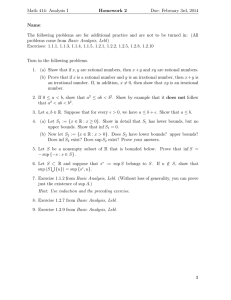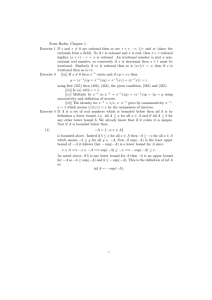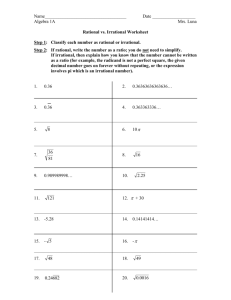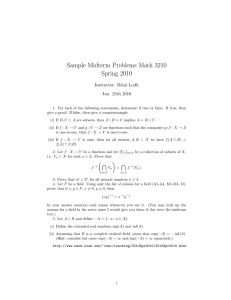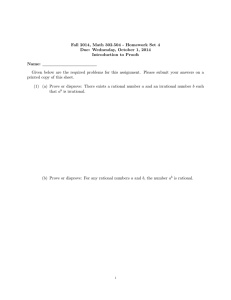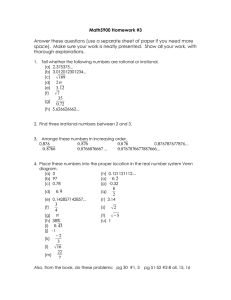Chapter 1 Additional Problems
advertisement
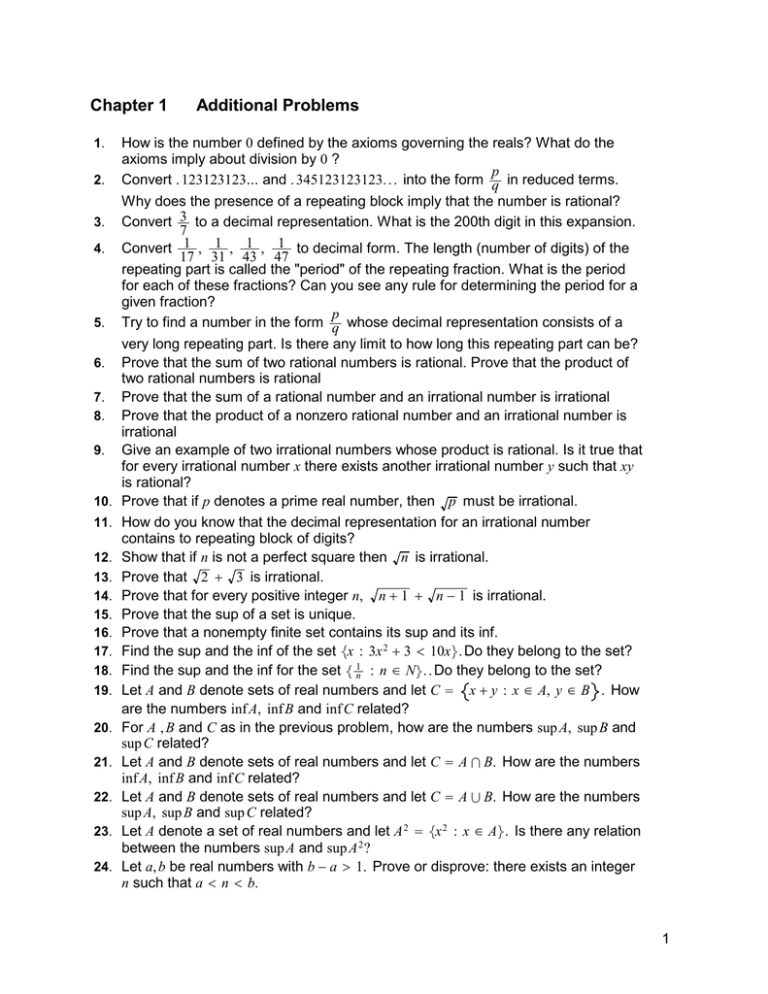
Chapter 1 1. 2. 3. 4. 5. 6. 7. 8. 9. 10. 11. 12. 13. 14. 15. 16. 17. 18. 19. 20. 21. 22. 23. 24. Additional Problems How is the number 0 defined by the axioms governing the reals? What do the axioms imply about division by 0 ? p Convert . 123123123... and . 345123123123. . . into the form q in reduced terms. Why does the presence of a repeating block imply that the number is rational? Convert 3 to a decimal representation. What is the 200th digit in this expansion. 7 Convert 1 , 1 , 1 , 1 to decimal form. The length (number of digits) of the 17 31 43 47 repeating part is called the "period" of the repeating fraction. What is the period for each of these fractions? Can you see any rule for determining the period for a given fraction? p Try to find a number in the form q whose decimal representation consists of a very long repeating part. Is there any limit to how long this repeating part can be? Prove that the sum of two rational numbers is rational. Prove that the product of two rational numbers is rational Prove that the sum of a rational number and an irrational number is irrational Prove that the product of a nonzero rational number and an irrational number is irrational Give an example of two irrational numbers whose product is rational. Is it true that for every irrational number x there exists another irrational number y such that xy is rational? Prove that if p denotes a prime real number, then p must be irrational. How do you know that the decimal representation for an irrational number contains to repeating block of digits? Show that if n is not a perfect square then n is irrational. Prove that 2 + 3 is irrational. Prove that for every positive integer n, n + 1 + n − 1 is irrational. Prove that the sup of a set is unique. Prove that a nonempty finite set contains its sup and its inf. Find the sup and the inf of the set x : 3x 2 + 3 < 10x. Do they belong to the set? Find the sup and the inf for the set 1n : n ∈ N. . Do they belong to the set? Let A and B denote sets of real numbers and let C = x + y : x ∈ A, y ∈ B . How are the numbers inf A, inf B and inf C related? For A , B and C as in the previous problem, how are the numbers sup A, sup B and sup C related? Let A and B denote sets of real numbers and let C = A ∩ B. How are the numbers inf A, inf B and inf C related? Let A and B denote sets of real numbers and let C = A ∪ B. How are the numbers sup A, sup B and sup C related? Let A denote a set of real numbers and let A 2 = x 2 : x ∈ A. Is there any relation between the numbers sup A and sup A 2 ? Let a, b be real numbers with b − a > 1. Prove or disprove: there exists an integer n such that a < n < b. 1 25. Show that the set of rational numbers q such that q 2 < 2 has no sup. (Note: this 26. 27. 28. 29. 30. 31. 32. 33. 34. 35. 36. 37. 38. does not say the set q 2 < 2 has no real number supremum). Show that there exists a real number x > 0 such that x 2 = 2. Hint: Let S = x > 0 : x 2 < 2 and let r = sup S. Then show r 2 = 2. Show that 2 ∈ 1, 2. Bisect this interval and locate 2 in one of the two half intervals. Continue bisecting intervals to generate a sequence of closed bounded intervals, all of which contain 2 . Does this procedure prove there exists a real number whose square equals 2? Show that there exists a real number x > 0 such that x 3 = 5. Hint: is the set S = x : x 3 < 5 bounded above? Let A and B denote sets of real numbers and define δA, B = inf |x − y| : x ∈ A, y ∈ B ; i.e., δA, B is the "distance" between A and B. a. Find δA, B if A = even integers and B = odd integers b. Find δA, B if A = N and B = R\N c. Find δA, B if A = N and B = ℚ\N d. Find δA, B if A = 2 and B = ℚ. e. What does δA, B represent if A and B are finite sets? m : m ∈ N . Find the largest interval a, b which contains no Let A = 10 10 elements of A. Under what conditions is sup A not an accumulation point for A? Let p be an accumulation point for A ⊂ R. Show there exists a sequence of points in A that converge to p. Suppose x ∈ 0, 1 has decimal expansion 0. d 1 d 2 . . . d n . . . with d i = 0 for i ≥ 12. Where is x located in the intervals of length 10 −i , i ≥ 12 to which x belongs? Discuss the equality or nonequality of the numbers a = 1. 000. . . and b =. 999. . . ? Discuss whether axiom 13 asserts that either a = b or else there exists > 0 such that a does not belong to N b. Suppose unequal real numbers a = N. a 1 a 2 . . . and b = N. b 1 b 2 . . . are such that a i = b i for i ≤ 12. Give a decimal expansion for a rational number between a and b. Give a decimal expansion for an irrational number between a and b. Describe the set of all x in 0, 1 whose ternary expansions contain no 1 ′ s (only 0 ′ s and 2 ′ s). This set is called the Cantor set. Suppose a and b are real numbers with a + b > 0. Show that δ > 0 can be found such that u + v > 0 for all u ∈ N δ a and v ∈ N δ b. 2
